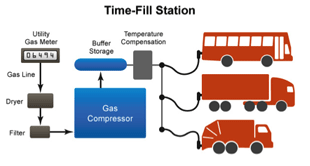Time-Fill CNG Fueling Stations
 Time-fill CNG stations are used primarily by fleets. This type of setup works great for vehicles with large tanks that refuel at a central location every night. Time-fill CNG stations can also work for small applications, such as a small station at a driver’s home. At a time-fill CNG station, a fuel line from a utility delivers fuel at a low pressure to a compressor on site. Unlike fast-fill CNG stations, time-fill CNG stations may have smaller compressors and the vehicles are generally filled directly from the compressor, not from fuel stored in tanks. Although there is a small buffer storage tank, its purpose is not to fill vehicles, but to keep the compressor from turning off and on unnecessarily and wasting electricity.
Time-fill CNG stations are used primarily by fleets. This type of setup works great for vehicles with large tanks that refuel at a central location every night. Time-fill CNG stations can also work for small applications, such as a small station at a driver’s home. At a time-fill CNG station, a fuel line from a utility delivers fuel at a low pressure to a compressor on site. Unlike fast-fill CNG stations, time-fill CNG stations may have smaller compressors and the vehicles are generally filled directly from the compressor, not from fuel stored in tanks. Although there is a small buffer storage tank, its purpose is not to fill vehicles, but to keep the compressor from turning off and on unnecessarily and wasting electricity.
The time it takes to fuel a vehicle depends on the number of vehicles, compressor size, and the amount of buffer storage. Vehicles may take several minutes to many hours to fill. The advantage of time-fill is that the heat of recompression is less so you usually get a fuller fill than with fast-fill. And you can control when you fill the vehicles, and thus, get better electricity rates needed to run the compressor, such as off-peak hours at night.
Time-fill CNG stations are carefully architected based on the application. A transit bus company may need a larger compressor that can deliver 8 to 9 gallons per minute, while a refuse truck company may be fine filling trucks at 3 gallons per minute using a smaller compressor. A consumer application may need far less—such as, less than half of a gallon an hour. These differences account for the large variance in the cost of installation.
Benefits of a Time-Fill CNG Fueling Station
- Time filling allows a fleet to fill overnight while trucks are not in service.
- Reduce cost associated with drivers waiting each day to fill their vehicles. On average, saves 60 hours per year - per truck.
- Use smaller compressors and related equipment verses fast-filling to achieve fuel production. Typical time-fill CNG systems cost 30% less than fast-fill CNG systems.
- Reduce electric costs to operate compressors by filling trucks during off-peak hours.
- Compressors start and stop only one time per day. Reduces maintenance and extends the life of the equipment.
- Complete 100% fill achieved with every fill when compared to fast-fill.
- Requires less hourly gas flow than a fast-fill CNG system. Utility extensions are typically minor.
- Production costs are lower than fast-fill CNG systems.
- Filling the vehicles will happen automatically when the vehicle is connected to the hose and will shut off when the vehicle is full. Timers can turn the station on and off each day automatically.
